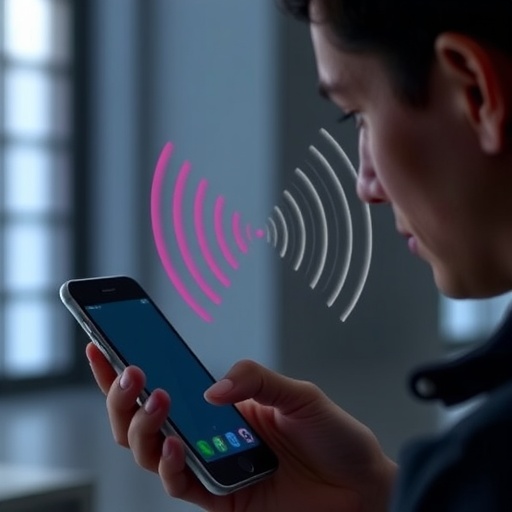In an intriguing exploration of surveillance technology, a groundbreaking study conducted by researchers at Penn State University has uncovered the potential of “wireless-tapping,” a method that leverages radar technology to remotely capture and decipher conversations from a cellphone’s earpiece. The researchers have demonstrated that with the right equipment and algorithms, transcriptions of phone calls can be generated from vibrations emitted by the device, even when the phone is up to three meters away. This revelation poses significant implications for privacy, especially in an era marked by growing concerns over digital surveillance and data security.
The findings of this research, set to be published in the Proceedings of WiSec 2025, raise pressing questions about the future of personal privacy. The study, while still in its nascent stages, reports an accuracy rate of approximately 60% for transcribing conversations, albeit with a vocabulary limited to the use of about 10,000 unique words. This level of accuracy indicates that while the technology is not yet perfect, it is sufficiently advanced to raise alarms about the ease with which private communications could be accessed by malicious entities.
Suryoday Basak, a doctoral candidate in computer science and the first author of the study, explains that the vibrations produced during phone calls can be captured by specialized radar devices. Unlike conventional eavesdropping techniques, which often involve direct access to communication lines, this approach utilizes machine learning algorithms to interpret the vibrations as human speech. Basak underscores the significance of these findings, stressing that the goal is not merely to showcase technological advancement but to instigate an informed public dialogue regarding the privacy risks accompanying such innovations.
The research builds upon a previous project initiated in 2022, wherein the team had successfully adapted radar and voice recognition technology to identify a limited set of predefined words with remarkable precision. However, this latest endeavor expands the scope dramatically—the researchers have adapted the “Whisper” speech recognition model, an open-source AI tool, to not only recognize the basic vibrations from cellphones but also to convert them into coherent transcriptions of spoken conversations. This adaptation involves sophisticated programming techniques, enabling the model to decipher what is being said despite the inherent noise and distortion present in radar data.
The capabilities of their radar setup hinge on the utilization of millimeter-wave radar technology, a powerful tool typically employed in self-driving vehicles, motion sensing devices, and advanced wireless communications, including 5G networks. By employing such technology, the researchers aim to push the boundaries of what is possible in non-invasive surveillance. The researchers chose to use readily available technology, showcasing how high-end surveillance methods could potentially be scaled down to fit into compact objects, making them accessible for broader usage.
To refine their model, the researchers implemented a unique adaptation technique known as low-rank adaptation. This method allowed them to customize only a small fraction—approximately 1%—of the parameters in the Whisper model, ensuring efficiency in processing while still enhancing capability for interpreting the radar-derived speech patterns. This technical maneuvering highlights the intersection of machine learning and real-world applications, melding advanced theoretical research with practical implications in privacy and security.
During their experiments, the team meticulously positioned the millimeter-wave radar sensor a few feet away from the calling cellphone. The sensor then captured the subtle oscillations of the device as it transmitted audio through its earpiece, generating a complex signal that was subsequently processed by their advanced speech recognition model. The results, while promising, underscore the necessity for future improvements, particularly in achieving higher accuracy rates. Incorporating contextual data for manual corrections is identified as a viable strategy to enhance existing transcription results, ultimately empowering this technology for more comprehensive analysis.
Reflecting on previous analogs of communication interception, Basak draws a parallel between their findings and the technique of lip-reading. Just as individuals adept in lip-reading utilize context and visual cues to glean insights from limited information, their study reveals that the output from the radar surveillance combined with contextual relevance can enable a form of conversation interpretation from a distance. The implications of this research are profound, suggesting that as the technology matures, the ability to discern private dialogues could become disturbingly accessible to those with malicious intent.
Consciously, the researchers aim to raise awareness among the public regarding the inherent risks posed by these technological advancements. By showcasing the potential for remote eavesdropping facilitated by refined radar technology and machine learning applications, they advocate for heightened vigilance among individuals, particularly when engaging in sensitive discussions via mobile devices. The study serves as a critical reminder of the dual-edged sword that technology represents, simultaneously facilitating advancements and posing new challenges to personal privacy.
As the researchers underscore, the tech community and society at large must consider the ethical implications of such advancements. Recognizing that the tools meant for safeguarding security can also be weaponized against personal privacy creates a pressing need for regulations and conversations surrounding the permissible boundaries of surveillance in the digital age. The Penn State team’s work could potentially act as a catalyst for future disclosures on surveillance ethics, privacy rights, and the capabilities of evolving technology.
Finally, the study received support from the U.S. National Science Foundation, highlighting the growing interest in government and academic circles to explore and address burgeoning threats to cybersecurity as technology becomes ever more sophisticated. This convergence of governmental and academic support illustrates a unified effort to balance technological advancement with the preservation of civil liberties.
In a world where digital privacy continues to erode, the revelation of wireless-tapping serves as a critical wake-up call. It compels us to question the technologies we take for granted and to remain steadfast in protecting our personal boundaries against encroaching surveillance. As society adapts to these rapidly evolving landscapes, the conversation surrounding the intersection of technology and privacy is more relevant than ever.
Subject of Research:
Article Title: Wireless-Tap: Automatic Transcription of Phone Calls Using Millimeter-Wave Radar Sensing
News Publication Date: 30-Jun-2025
Web References:
References:
Image Credits:




